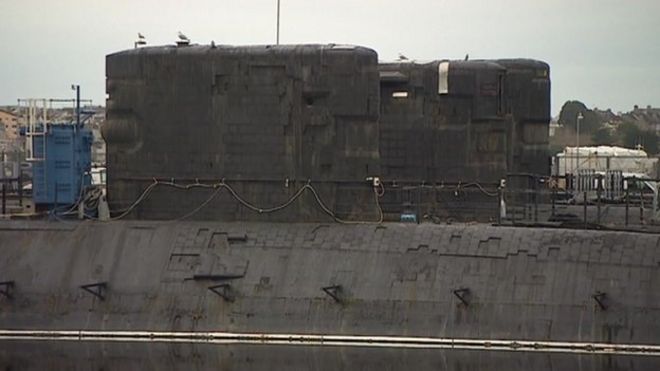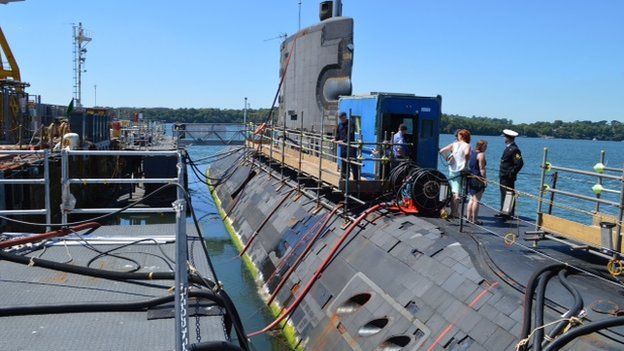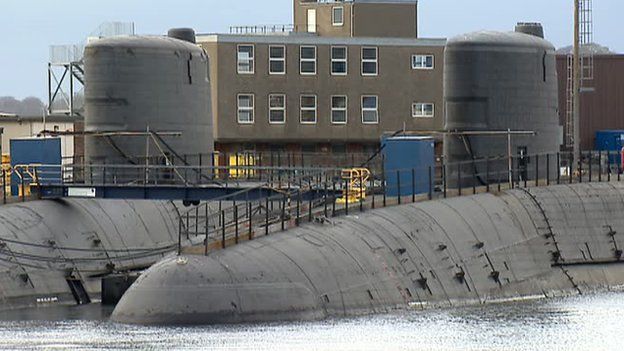
Storing and maintaining Britain's 19 laid-up nuclear submarines has cost taxpayers more than £16m over the last five years, it has emerged.
The out-of-service vessels have been stored at Rosyth in Fife since 1980 and Devonport in Plymouth since 1994.Campaigners have raised concerns about the hulks' safety, blaming a "lack of decision" for the delay in dismantling.
The Ministry of Defence (MoD) said it took its duty to manage disposal of submarines "very seriously".
A Freedom of Information request submitted to the MoD by the BBC revealed the combined cost of preventing any nuclear materials on board getting into the environment from the seven submarines at Rosyth and 12 in Devonport.

Cost of storing and maintaining laid-up nuclear submarines
Rosyth- 2009/10: £1.1m
- 2010/11: £2.4m
- 2011/12: £4.6m
- 2012/13: £3.8m
- 2013/14: £1.6m
- 2009/10: £0.5m
- 2010/11: £0.3m
- 2011/12: £0.4m
- 2012/13: £0.1m
- 2013/14: £1.8m




- No site has been agreed to take the radioactive reactors
- Devonport has 12 submarines: four defueled, eight with fuel
- Rosyth has seven submarines, all defueled
- The oldest submarine is HMS Dreadnought in Rosyth, decommissioned in 1980
- The latest laid-up submarine is HMS Tireless in Devonport, decommissioned in 2014

It said in documents that the "cost to the taxpayer of maintaining them safely is rising significantly as they age and as more submarines leave service".
But it said dismantling could not take place until it found a site for temporary storage of the submarines' radioactive reactors.
'Huge embarrassment'
A decision on a site is expected later this year after public consultation finished in February.A test dismantling of a submarine at Rosyth is due to start in January next year, according to the MoD.
Ian Avent, of Plymouth campaigners Community Awareness Nuclear Storage and Radiation, said: "The big problem is that eight submarines on Devonport still have their fuel on board and that is potential for [a] disaster.
"The submarines are a huge embarrassment for the MoD.
"They need to make a decision soon on where they are going take the waste fuel so dismantling can start."
Nuclear engineering consultant John Large blamed a "lack of decision and decisive management of the decommissioning and dismantling" of the submarines.
'Continuing radiological risk'
He said it could take several years for each to be decommissioned."It also exposes the public, and the naval base workforce, to continuing radiological risk arising from untoward accident or incident," he said.
Jane Tallents, an adviser on the MoD's submarine dismantling project and a member of anti-nuclear group Trident Ploughshares in Scotland, said: "The MoD dragged its feet after the first submarine was laid up but 12 years ago they decided to do something.
"It is a complicated project and there have been points where they have stalled and gone slowly but they have kept moving with it."
The MoD said all the stored submarines "undergo regular maintenance to keep them in a safe condition".
A spokesperson said: "As a responsible nuclear operator the MoD takes its duty to manage the disposal of submarines very seriously.
"All activity is undertaken in a safe, secure, cost-effective and environmentally sound manner."


No comments:
Post a Comment